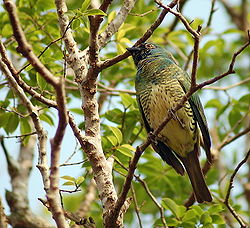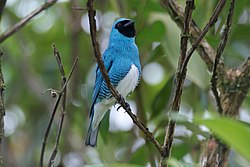| Swallow tanager | |
|---|---|
 | |
| Female | |
 | |
| Male in Paraná, Brazil | |
| Scientific classification | |
| Kingdom: | Animalia |
| Phylum: | Chordata |
| Class: | Aves |
| Order: | Passeriformes |
| Family: | Thraupidae |
| Genus: | Tersina Vieillot, 1819 |
| Species: | T. viridis |
| Binomial name | |
| Tersina viridis (Illiger, 1811) | |
 | |
The swallow tanager (Tersina viridis) is a species of Neotropic bird in the tanager family Thraupidae. It is the only member of the genus Tersina. It is found widely throughout South America, from eastern Panama to far northern Argentina. The species is sexually dimorphic: the female is a yellow-green and the male a turquoise blue with a small deep black face and upper throat patch.
